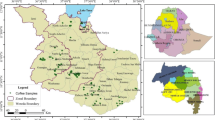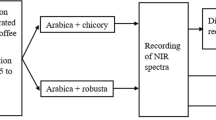Abstract
Samples of green coffee (Coffea arabica) produced in the crop year 1999/2000 in Minas Gerais state, Brazil, were analyzed for the elements Al, Ba, Br, Ca, Cl, Co, Cs, Cu, Fe, K, Mg, Mn, Na, Rb, S, Sc, and Zn using instrumental neutron activation analysis (INAA), in an attempt to establish fingerprints of organically grown coffee. Using data mining/KDD techniques the elements Br, Ca, Cs, Co, Mn, and Rb were found to be suited as markers for discrimination of organic from conventional coffees.
Similar content being viewed by others
Author information
Authors and Affiliations
Additional information
Received: 12 April 2002 Accepted: 31 July 2002
Acknowledgments The authors wish to thank the financial support supplied by FAPESP and CNPq; and TUDelft for granting a research fellowship to Mr. Tagliaferro. Thanks are also given to MINASCOFFEE for supplying the coffee samples, and to an anonymous referee for valuable comments.
Rights and permissions
About this article
Cite this article
De Nadai Fernandes, E., Tagliaferro, F., Azevedo-Filho, A. et al. Organic coffee discrimination with INAA and data mining/KDD techniques: new perspectives for coffee trade. Accred Qual Assur 7, 378–387 (2002). https://doi.org/10.1007/s00769-002-0531-6
Issue Date:
DOI: https://doi.org/10.1007/s00769-002-0531-6




